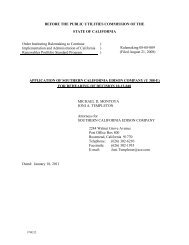here - The Vote Solar Initiative
here - The Vote Solar Initiative
here - The Vote Solar Initiative
You also want an ePaper? Increase the reach of your titles
YUMPU automatically turns print PDFs into web optimized ePapers that Google loves.
corporation on the “total costs” expended above the MPR for “the procurement of eligible<br />
renewable energy resources to achieve the annual procurement targets established” under the<br />
RPS program. Resolution E-4199 implemented this statutory provision and adopted an abovemarket<br />
funds (“AMFs”) cost limitation for PG&E, which PG&E exhausted in 2009. 5/<br />
Public<br />
Utilities Code Section 399.15(d)(3) provides that once an electrical corporation’s cost limitation<br />
is exhausted, the Commission “shall allow the electrical corporation to limit its procurement to<br />
the quantity of eligible renewable energy resources that can be procured at or below” the MPR.<br />
Under the Decision, PG&E’s obligation to procure renewable resources under the RAM<br />
program is not limited to accepting only those offers priced at or below the MPR. By failing to<br />
expressly state that PG&E has no obligation to procure any resources under the RAM program<br />
whose prices exceed the MPR, the Decision violates Section 399.15(d)’s prohibition on requiring<br />
an electrical corporation to procure above-MPR resources after it has exhausted its AMFs cost<br />
cap.<br />
While the Decision does provide PG&E with the discretion to reject offers if they are not<br />
competitive with other renewable opportunities, 6/ this does not remedy the Decision’s legal error,<br />
because the Commission could not have intended “competitive” to mean priced at or below the<br />
MPR. <strong>The</strong> Commission has routinely approved above-MPR priced RPS contracts as<br />
reasonable, 7/ thus indicating that a competitively-priced RPS contract is not limited to one priced<br />
at or below the MPR. <strong>The</strong> Commission has also clearly defined the MPR as representative of the<br />
cost of a non-renewable energy source, not the cost of a renewable energy source, 8/ thus<br />
5/ PG&E was notified via letter from the Director of Energy Division on May 28, 2009 that it had exhausted<br />
its AMFs cost limitation.<br />
6/ Decision at 36.<br />
7/ See e.g., Res. E-4375; Res. E-4369; Res. E-4366; Res. E-4356.<br />
8/ D.04-06-015 at 7, n. 10 (“[W]e will clarify also what the MPR is not: it does not represent the cost,<br />
capacity or output profile of a specific type of renewable generation technology…. [T]he MPR is to<br />
3



